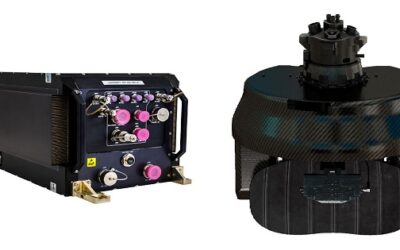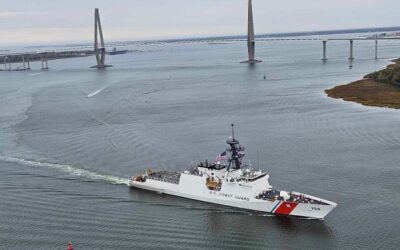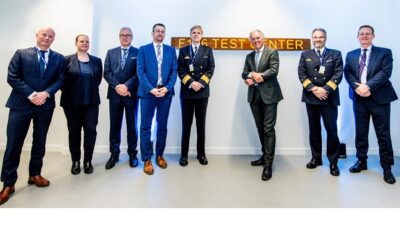Today the US Navy invited media to a visit to see the Boeing P-8A POSEIDON stationed at Whidbey Island Naval Air Station (north of Seattle). Stationed there is one of the two Fleet Training Centers (FTC) with the 2nd being in Jacksonville, FL. They are responsible for crew training and the transition from the P-3 ORION to the P-8A POSEIDON.
The P-8A POSEIDON is a Multimission Maritime Aircraft (MMA) and a modified 737-800ERX. The P-8 conducts anti-submarine warfare (ASW), anti-surface warfare (ASUW), and shipping interdiction, along with an early warning self protection (EWSP) ability, otherwise known as electronic support measures (ESM). This involves carrying torpedoes, depth charges, HARPOON anti-ship missiles, and other weapons.
It is able to drop and monitor sonobuoys, is designed to operate in conjunction with the Northrop Grumman MQ-4C TRITON Broad Area Maritime Surveillance unmanned aerial system (UAS(.
Other users are India (P-8I NEPTUNE), the Royal Australian Air Force (RAAF), and the UK’s Royal Air Force (RAF), with the Royal Norwegian Air Force (RNoAF) not being a customer yet, but has publicly stated an interest and is working together with the US government on the FMS process. Inside the P-8A, the crew can work at five workstations. A 6th workstation is planned and integration should start later this year. Also on board are three rotary launcher (for 10 buoys) and single launcher for the up to 129 buoys as a standard mission package. The crew can select of different buoys types. For example with the sonobuoys AN/SSQ-53F (passive, just listening) or the SSQ-62E (active, with pinging).
As a next step new types will be available: SSQ-53G (like the SSQ-53F but with GPS-signal) or the SSQ-62F (like SSQ-62E but with GPS-signal). The buoys can also measure the water temperature and depth for tactical reasons. Under wing weapon stations can carry Boeing AGM-84D Block IC HARPOON anti-ship missiles. In the future there will be two more under wing weapon stations available, not approved yet. And there are another five in the front fuselage, mines will be the most probably used weapons there.
Also on board is the Raytheon Mark 54 Lightweight Hybrid Torpedo (LHT), the standard 12.75in (324mm) ASW torpedo used by the US Navy (USN). One of the main P-8A capabilities will be the High Altitude Anti-Submarine Warfare Weapon Capability (HAAWC) Air Launch Accessory (ALA), turning a Mark 54 torpedo into a glide bomb for deploying from up to 30,000ft (9,100 metres).
The USN has 12 VPs (Patrol Squadrons), so far there are seven squadrons of P-8A POSEIDONs implemented, six at the east coast and one on the west coast, the rest is still on P-3. The VP4 (mission squadron) was just transitioned from the P-3 ORION and has currently two airplanes at Whidbey Island Naval Air Station. All other squadrons have between four and nine airplanes.
At the moment, Boeing is delivering 1-2 aircraft to the USN each month. 111 P-8A are funded so far, but more (117) are wanted by the USN to replace the 200+ P-3 ORION. All ORIONs will stay in service with the reserves – for several more years. In Whidbey Island there are 23 P-3 left.
The transition training takes six months. 80% of the training is based on simulation, the rest inside the real P-8A. With the P-3 ORION it was more like 50/50. There are several simulation levels available, from a desktop trainer to a Full Flight Simulator Level D (FFS). There are three FFS available at Whidbey Island Naval Air Station, four more to come and another ten in Jacksonville, FL/USA.
Each pilot gets 29 sets of simulation training with four hours (2 hrs. in each pilot seat). In the FFS every training is possible. Everything is software based, so new capabilities and features can fast an easily be implemented. At the end there is one instructor for one trainee in the Weapon Tactics Trainer (WTT), the high-end simulator for the crew. A crew consist of two to three pilots and three operators (acoustic and non-acoustic), depending on the type and length of mission. With the 6th workstation there will be another operator added. The mission commander can be a pilot or one of the “backseater.”
Duration at the moment is 11+ hours, but air-to-air refuelling will be one of the next capabilities upgrades and make the missions even longer. But the P-8A can fly faster and reach the mission area faster, has more range and duration, and with the new technologies there are more capabilities available and possible in the future. The aircraft has a built in growth capability of 24,000 pounds. With the rise of submarines operated worldwide, the crews will have a lot to do in their career.
Andre Forkert

























